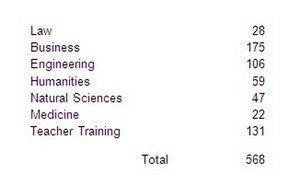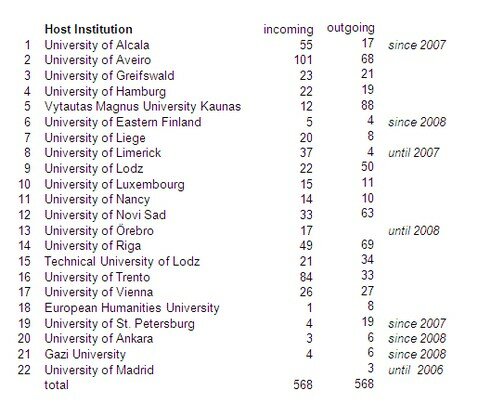3. SUCCESS INDICATORS
From 2004-2009 more than 550 students participated in the CE program. The students came from the following fields of study:

Number of CE movers received and sent by the following universities:

The European University Foundation – Campus Europae is a pan-European network of universities for enhanced student exchange and academic development in a European context. The partner universities are:
The main objective of Campus Europae (CE) is to enhance student mobility in the framework of the network of member universities. Campus Europae movers have the opportunity to spend two years of their combined undergraduate and graduate studies at two different universities in addition to their home institution. This enables them to learn the two languages of the host universities with the objective to actively take part in the academic, social and cultural life of the host university.
On of the aims of CE is to promote all languages spoken and taught at the member institutions; and especially to motivate students to learn minor languages. In order to fulfill the requirements which lead to the awarding of a certificate, or in case of two completed years a degree, students have to learn the official language of the host university. Therefore in the framework of the CE-network the following languages are taught: French, German, Spanish, Italian, Portuguese, Polish, Serbian, Lithuanian, Latvian, Russian, Turkish and Finnish. Luxemburgish maintains a status of exclusivity.
According to the Campus Europae language concept students learn a language in three main phases:
Intensive courses as well as the accompanying language courses during the first and the second semester are obligatory for CE participants. In most universities both courses are awarded ECTS credits. Universities are encouraged to offer courses in English for international students during the first semester in order to facilitate the language transition into the local language. However, not all study programs are adjusted to provide enough courses in English. The Campus Europae Student Council is a provider of the ‘Buddy Network’ – a network of local students who provide mentors for every CE mover. They help incoming students to get acquainted with a university, city and local student life. In this way CE movers get integrated in a local community more quickly, which facilitates the language learning process.
A supporting part in the CE (language) concept are Learning Employability Places (LEPs). Students have an opportunity to combine their exchange year with a professional experience in local enterprises or institutions. LEPs only occupy a limited time budget but are intended to last throughout the exchange year in order to continuously improve the subject-related language skills in a professional environment.
.
The situation of Campus Europae students is specific because they have to learn a foreign language in a foreign environment together with international students who predominantly use English as a (transitional) bridge-language. On the one hand these factors force CE-students to quickly make progress as to their language skills. But on the other hand they often feel tempted to use English outside the language classes. Therefore it is instrumental to intensify the time students spend in the language classes with their language tutor (at least during the introductory course prior to the beginning of a semester).
The main goal of CE language concept is to:
In addition, CE is designed to send students twice for one year to two different foreign universities. Gaining the academic, linguistic and professional experience, students are able to compare at least three different foreign but European cultures and to better identify differences as well as similarities, thus receiving a broader picture of Europe’s diversity.
The CE strategy can be a promising method to reach one of the eight key competences in European Union: to speak two foreign languages.
From 2004-2009 more than 550 students participated in the CE program. The students came from the following fields of study:

Number of CE movers received and sent by the following universities:

Campus Europae offers its partner universities financial support (up to 5 000 EUR) to organize intensive language courses, 6 hours a day, 6 weeks prior to the beginning of an academic year. The integration of language learning as a mandatory part of the exchange year and the awarding of a certification of the acquired language proficiency further motivate students to study the language of their host institution. The possibility to take part in study related internship adds to this experience. Regular4 meeting between the relevant organizational units help to identify problematic issues and exchange good practices.
IIn the Campus Europae program motivation is mainly based on fast progressing improvement and possibility to intensively use newly learnt linguistic skills in practice.
Incoming students are required to have basic communication skills before the classes start, so that they can integrate in a local academic life using the local language. Hence, they are offered the introductory intensive language courses already before the beginning of a study year. They should be organized in a way which limits a use of English among students and enhances a use of a local language. It is possible to achieve through 4-6 weeks course with 6 hours a day. In this way students stay occupied with language learning till afternoon and have the possibility to stay in a same group of people who learn and want to use a local language during a lunch break.
The methodology plays a very important role in motivating students. It should enable learners to gain the communicative skills as soon as possible.
The assistance of local students (Buddy Network) is also crucial. They can help incomers to improve the language skills in a form of a tandem so that learners can still stay in a learning process after regular classes. Additionally, Buddy Network organizes a leisure time for incoming students which stimulates the integration between local and foreign students.
Student mobility practice shows that incoming students are usually accommodated all in one dormitory and separated from local students. The experience proves that multinational groups of students use English as a common communication code and avoid a use of a local language, even if they have already gained some skills. Moreover being in a separate dormitory limits their contact with local colleagues. Although it can be difficult from an administrative view, incoming students should be mixed in dormitories with local students. This solution would improve not only their language skills but also the cultural experience. The main obstacle for successful intensive courses prior to the beginning of academic year is a lack of financial support for the additional 6 weeks of a student’s stay.